Welcome to the ultimate guide to blue birds in Iowa! This beautiful state is home to a myriad of bird species, including several that boast stunning blue colors. Our free photo guide will not only help you identify these beautiful birds but also provide you with tips on the best spots to observe them in their natural habitats.
From the Eastern Bluebird to the Indigo Bunting, this guide covers it all. Grab your binoculars, download our free photo guide, and get ready to embark on an unforgettable bird-watching adventure in Iowa.
Blue Birds Found In Iowa
The geographic diversity of Iowa, with its mix of habitats ranging from wetlands and lakes to forests and grasslands, provides an ideal environment for a wide variety of bird species, including those with blue colors. The state’s rich vegetation offers ample food sources and nesting sites, attracting migratory birds as well as supporting resident populations.
Iowa’s position along the Mississippi Flyway, a major bird migration route, makes it a hotspot for bird watching, especially during the spring and fall migration seasons.
Eastern Bluebird
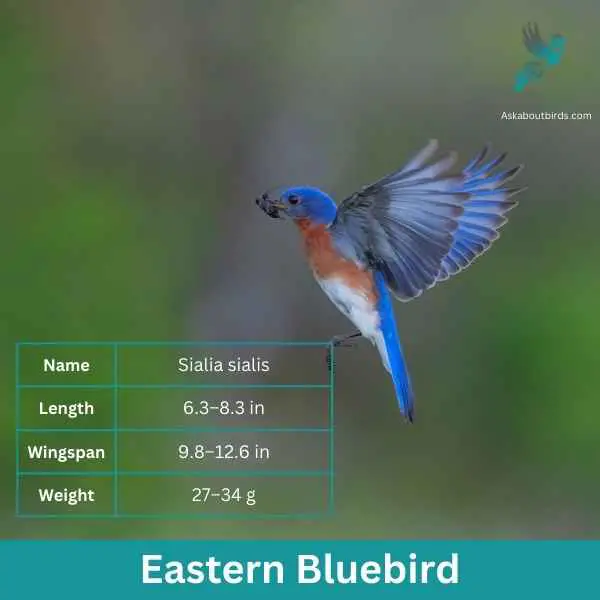
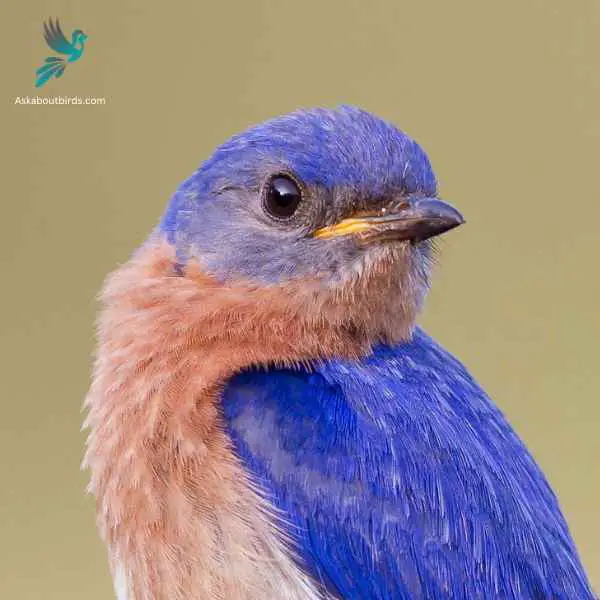
| Feature | Measurement |
|---|---|
| Scientific Name | Sialia sialis |
| Length | 6.3–8.3 in |
| Wingspan | 9.8–12.6 in |
| Weight | 27–34 g |
The Eastern Bluebird (Sialia sialis) is a small thrush found in open woodlands, farmlands, and orchards, and is recognized for its vibrant blue and red coloration. Male Eastern Bluebirds are dazzling with bright blue upperparts and a rusty or brick-red throat and breast, while females, though less colorful, still offer a similar pattern. The bird is native to North America and is commonly seen east of the Rockies, from Canada to the Gulf States and southeastern Arizona to Nicaragua.
Eastern Bluebirds feed on insects, wild fruit and berries. They have a gentle nature and are often seen perched alone or in small groups in the open, scanning the ground for prey. They are cavity nesters and will use old woodpecker holes or birdhouses if they are the right size.
Mountain Bluebird
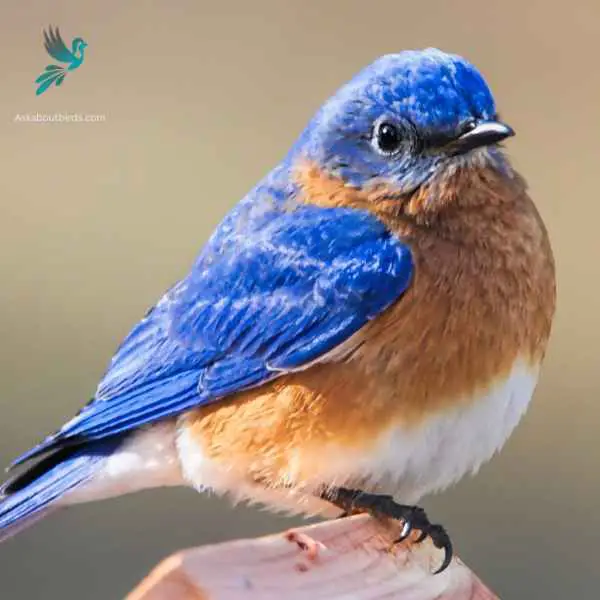
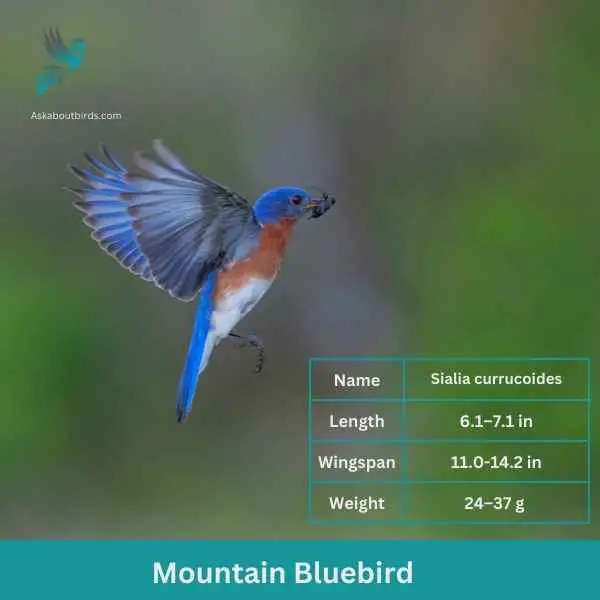
| Feature | Measurement |
|---|---|
| Scientific Name | Sialia currucoides |
| Length | 6.1–7.1 in |
| Wingspan | 11.0-14.2 in |
| Weight | 24–37 g |
The Mountain Bluebird is a small bird found in open grasslands and rocky mountains of North America. It is known for its stunning blue plumage, which is particularly vibrant in males. Females, on the other hand, have a more subdued blue coloration with hints of gray. These birds have slender bodies and a slightly curved bill, adapted for catching insects on the wing.
Mountain Bluebirds are insectivores, feeding primarily on insects such as beetles, grasshoppers, and spiders. They are skilled aerial hunters, capable of capturing their prey in mid-flight. During breeding season, these birds build their nests in tree cavities or man-made nest boxes, where females lay a clutch of eggs. The male bluebird actively participates in nest-building and provides food for the female during incubation.
Indigo Bunting


| Feature | Measurement |
|---|---|
| Scientific Name | Passerina cyanea |
| Length | 4.5–5.1 in |
| Wingspan | 7.1–9.1 in |
| Weight | 11.2–21.4 g |
The Indigo Bunting is a strikingly vibrant songbird, often hailed for its brilliant blue plumage and melodic song that graces woodlands and meadows during the warmer months.
Appearance: Males are renowned for their bright indigo blue feathers, which can appear darker in certain lights. Females and juveniles, on the other hand, are brown with subtle hints of blue on their wings and tail. The species lacks the vibrant streaking or spotting commonly found in many other songbirds.
Diet: Indigo Buntings primarily subsist on seeds, especially during non-breeding seasons. During the breeding season, they also consume a variety of insects such as beetles, caterpillars, and spiders, providing essential protein for their growing chicks.
Reproduction: Indigo Buntings build their nests close to the ground in shrubs or low tree branches. These nests, crafted meticulously with grasses and other plant materials, cradle clutches of typically 3 to 4 eggs. After hatching, the young are fed by both parents until they’re ready to fledge.
Blue Grosbeak
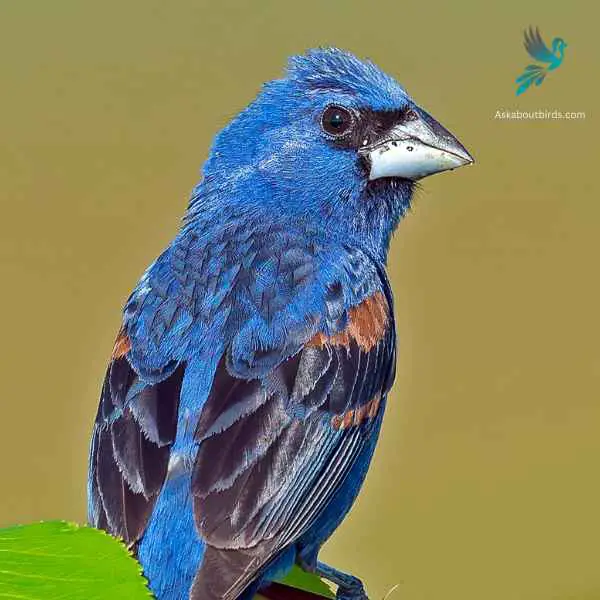

| Feature | Measurement |
|---|---|
| Scientific Name | Passerina caerulea |
| Length | 5.5 to 7.5 in |
| Wingspan | 10 to 11 in |
| Weight | 26 to 31.5 g |
The Blue Grosbeak is a medium-sized songbird found in North and Central America. The male Blue Grosbeak displays stunning plumage with deep blue feathers on its body and head, while the female has more subdued brownish tones. Both sexes have a thick, conical bill, which gives them their name “grosbeak,” meaning large beak.
These birds prefer open habitats such as grasslands, brushy areas, and woodland edges. Blue Grosbeaks are known for their melodious songs, which consist of a series of rich and varied notes. They primarily feed on seeds and insects, using their strong beaks to crack open seeds and forage on the ground or in low vegetation.
Blue Jay

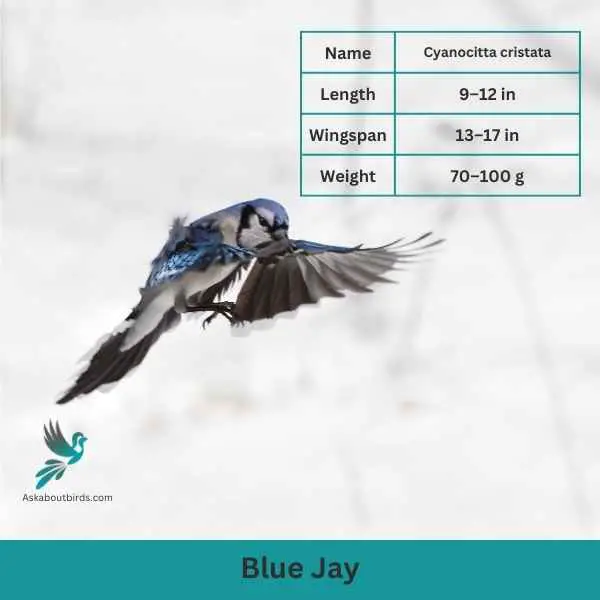
| Feature | Measurement |
|---|---|
| Scientific Name | Cyanocitta cristata |
| Length | 9–12 in |
| Wingspan | 13–17 in |
| Weight | 70–100 g |
The Blue Jay is a vibrant and easily recognized bird, known for its intelligence, distinctive calls, and bold behavior, commonly found throughout the eastern and central United States.
Appearance: The Blue Jay sports a striking blue upper body with white and black markings. Its face has a pronounced white patch with a black necklace that runs across the throat and around the head. The bird also features a pronounced blue crest, which can be raised or lowered, and its wings and tail are brightly colored with black bars and white tips.
Diet: Blue Jays are omnivores. Their diet consists primarily of seeds, nuts, especially acorns, fruits, and small insects. They’ve also been known to eat eggs or nestlings of other birds occasionally. Blue Jays often store food items in caches to eat later.
Reproduction: Blue Jays are monogamous birds that form long-lasting pair bonds. They typically build their nests in trees or large shrubs, constructing them from twigs, grass, and sometimes using mud as a binder. The female lays a clutch of 3 to 6 eggs, which are pale blue or sometimes white with brown speckles.
Belted Kingfisher

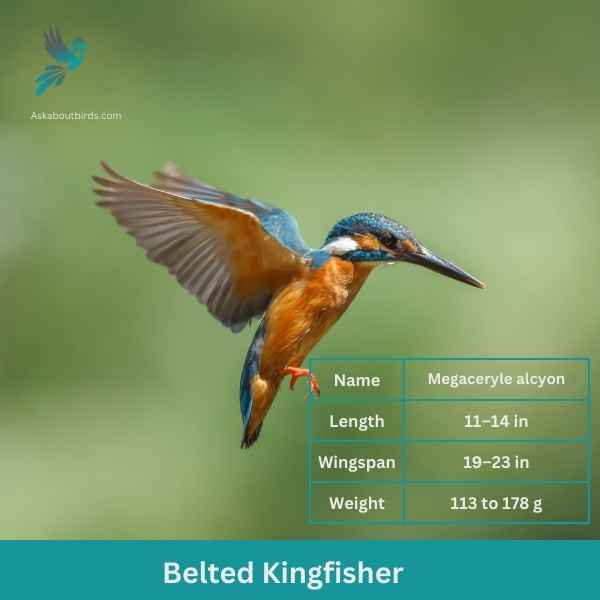
| Feature | Measurement |
|---|---|
| Scientific Name | Megaceryle alcyon |
| Length | 11–14 in |
| Wingspan | 19–23 in |
| Weight | 113 to 178 g |
The Belted Kingfisher is a distinctive and easily recognizable bird, frequently observed near water bodies, where it can be seen diving headfirst to catch prey.
Appearance: Sporting a prominent crest, the Belted Kingfisher has a slate blue-gray upper body and white underparts. Males possess a single blue band across their white chests, while females have an additional rufous band, making them one of the few bird species where females are more brightly colored than males. Their bill is long, sharp, and dagger-like.
Diet: As expert fishers, Belted Kingfishers mainly prey on small fish, but they’ll also consume crustaceans, insects, and amphibians. They’re known for their hunting tactic of hovering over water, spotting their prey, and then diving swiftly to snatch it.
Reproduction: Belted Kingfishers nest in burrows which they excavate in sandy or earthen banks, usually adjacent to water. The tunnel can be anywhere from 3 to 6 feet long, ending in a chamber. Within this chamber, the female lays a clutch of 5 to 8 white eggs.
Tree Swallow
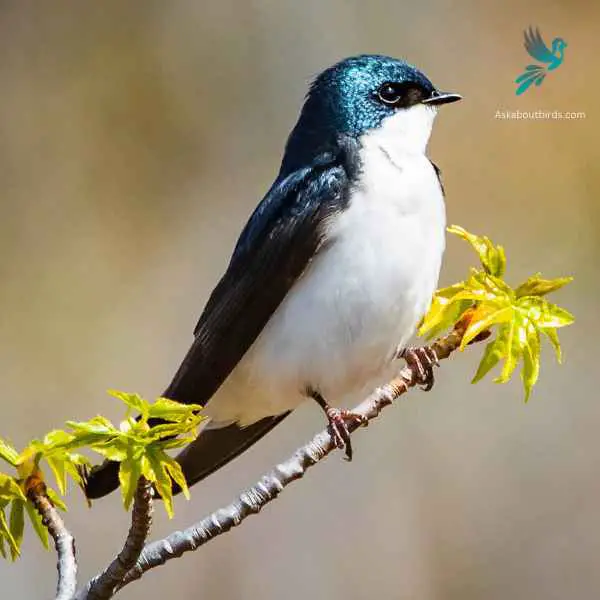
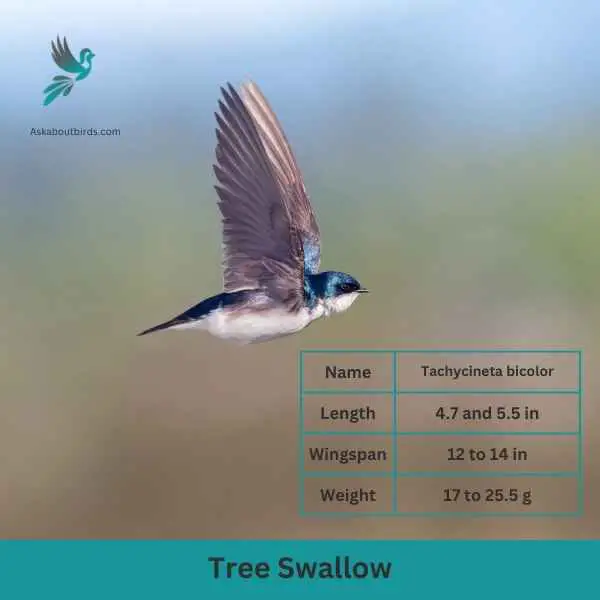
| Feature | Measurement |
|---|---|
| Scientific Name | Tachycineta bicolor |
| Length | 4.7 and 5.5 in |
| Wingspan | 12 to 14 in |
| Weight | 17 to 25.5 g |
The Tree Swallow is a graceful and agile bird, best recognized for its iridescent blue-green upperparts and sweeping flight patterns over open fields and water.
Appearance: The Tree Swallow is sleek with a streamlined body. The upperparts shine with a blue-green iridescence while the underparts are white. They possess long, pointed wings and a slightly forked tail, aiding in their agile flight.
Diet: Tree Swallows primarily feed on flying insects, skillfully catching them mid-air. During colder months when insects are scarce, they can switch to a diet of berries, particularly those of the bayberry, which other birds might find hard to digest.
Reproduction: Tree Swallows are cavity-nesters, typically choosing natural holes in trees or using bird boxes. They line their nests with feathers, creating a soft environment for the eggs. The female will lay a clutch of 4 to 7 white eggs.
Barn Swallow


| Feature | Measurement |
|---|---|
| Scientific Name | Hirundo rustica |
| Length | 6.5–7.5 in |
| Wingspan | 12.5–13.5 in |
| Weight | 16–22 g |
The Barn Swallow is a sleek, agile bird renowned for its graceful flight patterns and iconic forked tail, often seen darting over fields and water bodies in search of flying insects.
Appearance: Barn Swallows have deep blue, almost iridescent, upperparts and a rufous to tawny underbelly. Their distinctively forked tail and long wings give them a streamlined look. Both males and females have a similar appearance, though males often exhibit slightly brighter colors and a deeper fork in the tail.
Diet: Barn Swallows feed primarily on flying insects, which they catch in mid-air during their agile and acrobatic flights. Their diet includes flies, beetles, moths, and other small flying insects.
Reproduction: Barn Swallows are known for building their mud nests on man-made structures, particularly barns, bridges, and eaves. The nest is cup-shaped and made from mud pellets, often lined with feathers. The female lays a clutch of 4 to 6 eggs.
Common Grackle
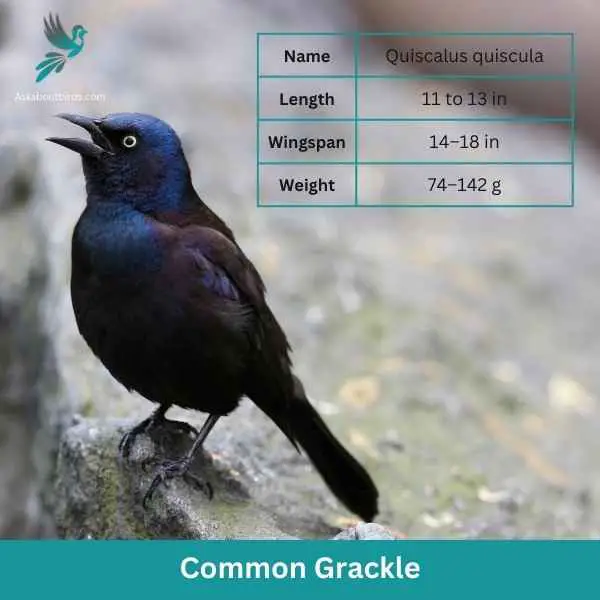

| Feature | Measurement |
|---|---|
| Scientific Name | Quiscalus quiscula |
| Length | 11 to 13 in |
| Wingspan | 14–18 in |
| Weight | 74–142 g |
The Common Grackle is a conspicuous bird found across much of North America, recognized for its glossy-black plumage, long tail, and piercing yellow eyes. Its vocalizations are varied and include a range of harsh, grating calls.
Appearance: The Common Grackle has a sleek black body with a glossy-iridescent sheen that can appear purple, green, or blue in certain lights. Its tail is long and keel-shaped. While both males and females have similar coloration, males are noticeably larger and shinier than females.
Diet: Common Grackles are omnivores. They primarily consume seeds, berries, and insects. However, they are also known to eat small fish, amphibians, and other birds’ eggs, especially when foraging on the ground or in shallow water.
Reproduction: Common Grackles breed in open and semi-open areas. The female typically selects the nest site and constructs a bulky nest made of grasses, twigs, and other plant materials, often in shrubs or trees. She lays a clutch of about 1 to 7 eggs, which are pale blue and spotted with brown.
Brown-Headed Cowbird

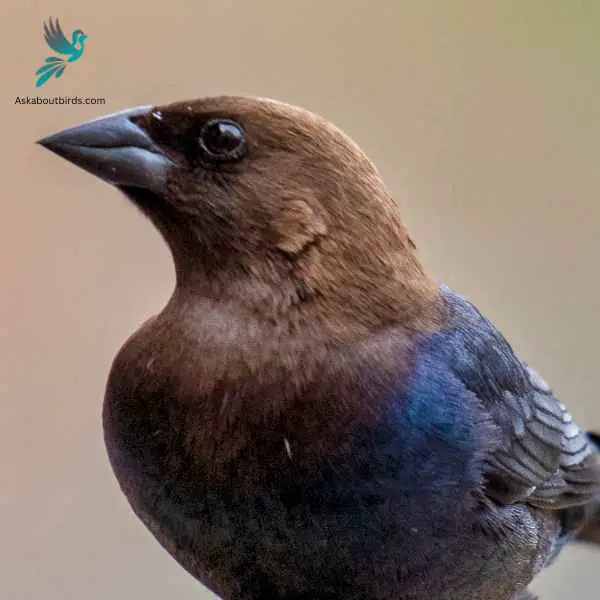
| Feature | Measurement |
|---|---|
| Scientific Name | Molothrus ater |
| Length | 6.3–8.7 in |
| Wingspan | 14 in |
| Weight | 30–60 g |
The Brown-Headed Cowbird is a unique North American bird known for its brood parasitism behavior. Rather than building its own nests, it lays its eggs in the nests of other bird species.
Appearance: Male Brown-Headed Cowbirds are glossy black with a distinct brown head, while females are plain gray-brown without the brown head. Both have a stout shape with a finch-like bill and a short tail.
Diet: Brown-Headed Cowbirds primarily feed on seeds, including grasses and grains. They also consume insects, especially during the breeding season. These birds often forage on the ground, commonly seen in open habitats like fields or pastures.
Reproduction: Unique among North American birds, the Brown-Headed Cowbird is a brood parasite. Instead of building its own nest, the female lays her eggs in the nests of other bird species. The unwitting host then raises the cowbird chick, often at the expense of its own offspring. The female can lay up to 40 eggs in a single breeding season, spread across multiple host nests.
Purple Martin
Scientific Name: Progne subis
Length: 7.5-9.1 in (19-23 cm)
Wingspan: 15.3-16.1 in (39-41 cm)
Weight: 1.9-2.3 oz (55-65 g)
The Purple Martin is a popular and widely recognized bird species, known for its acrobatic flight and social behavior.
Appearance: Purple Martins have a dark, glossy purple-blue plumage. Males are almost entirely dark purple while females and young birds have a lighter, greyish belly and throat.
Diet: The diet of Purple Martins primarily consists of flying insects such as beetles, flies, dragonflies, and moths. They catch their prey in mid-air while flying.
Reproduction: Purple Martins nest in colonies, often using artificial nest boxes provided by humans. The female typically lays a clutch of 4 to 6 white eggs, and both parents participate in incubating the eggs and feeding the chicks.
Where to Spot Iowa’s Blue Birds
Iowa is a treasure trove for bird enthusiasts, especially those with a penchant for blue birds. With its diverse habitats, the state hosts a variety of bird species throughout the year. Here are some of the top locations in Iowa known for their bird diversity:
- Neal Smith National Wildlife Refuge: Located near Prairie City, this refuge is home to over 200 bird species. The tallgrass prairie and oak savanna habitats attract a variety of birds, including Eastern Bluebirds.
- DeSoto National Wildlife Refuge: Situated along the Missouri River, this refuge is a major stopover for migratory birds. The wetlands and forests provide excellent habitat for various bird species, including the Blue Jay.
- Ledges State Park: Located near Boone, this park features a mix of forest and river habitats. It is a great spot to see a variety of woodland birds, including the Indigo Bunting.
- Hitchcock Nature Center: Located in the Loess Hills, this nature center provides a habitat for many bird species. The varied terrain of hills, forests, and prairies attracts species like the Eastern Bluebird.
- Lake Red Rock: This is the largest lake in Iowa and attracts a wide variety of waterfowl and shorebirds. The surrounding woodlands are also home to many songbirds, including the Blue-gray Gnatcatcher.
| Neighboring States | Top Spots for Blue Birds |
|---|---|
| Minnesota’s Blue Birds | 1. Itasca State Park 2. Tamarac National Wildlife Refuge 3. Sax-Zim Bog |
| Wisconsin’s Blue Birds | 1. Horicon Marsh National Wildlife Refuge 2. Crex Meadows Wildlife Area 3. Point Pelee National Park |
| Illinois’s Blue Birds | 1. Montrose Point Bird Sanctuary 2. Starved Rock State Park 3. Illinois Beach State Park |
| Missouri’s Blue Birds | 1. Riverlands Migratory Bird Sanctuary 2. Squaw Creek National Wildlife Refuge 3. Shawnee Trail Conservation Area |
| Nebraska’s Blue Birds | 1. Fontenelle Forest 2. Rowse’s 1+1 Ranch 3. Crane Trust Nature & Visitor Center |
| South Dakota’s Blue Birds | 1. Custer State Park 2. Big Sioux Recreation Area 3. The Outdoor Campus – West |
FAQs on Blue Bird Species Found in Iowa
Why is it important to put up nest boxes for bluebirds?
Eastern bluebirds, along with most bluebirds, are cavity-nesting birds, which means they prefer to build their nests in natural or artificial cavities, such as old woodpecker holes, dead trees and branches, or specially designed nest boxes. Unfortunately, suitable natural nesting sites are often scarce due to urbanization, removal of dead scattered trees, and competition from invasive species like European starlings. Therefore, providing nest boxes is crucial for the conservation efforts of these beautiful, blue-colored birds. Properly maintained bluebird houses can provide safe nest sites, helping to increase their population in the eastern half of North America. Remember to monitor the nest boxes regularly to ensure they are not being used by unwanted species and to clean them out after each breeding season.
How can I distinguish male eastern bluebirds from females?
The male eastern bluebird has bright, sky-blue plumage on its back, head, and tail feathers, while its belly is white with a hint of orange on the chest. The blue in the males is more vibrant and darker compared to the females. Female eastern bluebirds have a more subdued, bluish-gray back and head with a pale orange chest and white belly. Both males and females have white wing bars and a thin bill. Young bluebirds, both male and female, will have spotted breasts, and their coloration will be similar to adult females but duller. Remember, the intensity of the bluebird trail coloration can vary among individuals, and lighting conditions can also affect the perceived color.
How can range maps help in bird conservation?
Range maps, such as the indigo bunting range map and barn swallow range map, are essential tools for bird conservation efforts. These maps indicate the areas where a species is commonly found, including their breeding, non-breeding, and migration ranges. By understanding the distribution of a species, conservationists can identify key habitats, assess potential threats such as habitat loss or invasive species, and implement necessary conservation measures. Additionally, range maps can help bird watchers and researchers locate and study these birds, contributing to our overall knowledge and conservation strategies.
What is the significance of the bluebird’s bright colors?
The bright colors of the blue bird, particularly the male eastern bluebird, play a crucial role in attracting females during the breeding season. The males display their bright blue plumage, white belly, and sometimes bluish-gray on their back and tail feathers to attract females. These bright colors indicate a healthy and strong potential mate, which is preferred by females for producing healthy offspring. Moreover, the vibrant colors also help bluebirds identify each other and establish territories, which is essential for their survival in the wild.

